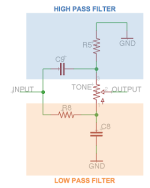Look at the schematic and compare it to the PCB:
View attachment 48085
When in the middle position, C8 is effectively bypassed completely, naturally the middle position is "FLAT" no matter which way the switch is oriented.
View attachment 48087 *Found diagram on Internet, forget where from so unfortunately no attribution
When connecting the switch's lug 1, the switch's bat will be in the DOWN position, effectively R12's resistance pushes some signal through the path of lesser resistance that is C8. Knowing that the bigger the capacitor the more bass gets through, and C8 is tiny so it's passing highs and blocking bass, I'll venture that this switch-position is a treble-boost — since this is a bass-pedal I'll guess that the signal is still managing to push through R12 and that C8 is siphoning/accentuating some highs which will accentuate the ATTACK of a note.
When connecting the switch's lug 3, the switch's bat will be in the UP position, which turns R12 and C8 into a filter:
View attachment 48086DIAGRAM by CODA EFFECTS
Obsidius' ATTACK has resistor inline with capacitor to ground, so it's formed an LPF, thus CUTting highs & passing lows.
Just to be sure, set your DMM to continuity "BEEP" mode, and place a probe on the top-most pad of the three ATTACK-switch pads. The switches aren't clearly labelled in the build-doc which is which, but if we use the DMM probes and the schematic we can figure it out.
GREEN shows a switch pad's lug-1 that's connected to a 470k, in turn connected to a 220p, that matches up with the ATTACK-sw in the schematic:
View attachment 48088
Looking at the schematic, the GRUNT switch doesn't have any 220p associated with it, but rather the schematic shows a 22n connected to GRUNT's lug-3, shown in
BLUE above. So now we know which switch is which.
Repeat the same process for GRUNT, compare the PCB to the schematic using the DMM continuity tester to confirm what is connected to what. Reason it out... Larger caps let more bass through.
While working on the pedal, components facing us, the switch on the right is ATTACK and on the left is GRUNT; so when the pedal is completed and on a pedalboard ATTACK is left and GRUNT right:
*
| SWITCH | ATTACK | GRUNT |
| UP | CUT | RAW (22n + 4n7) |
| MIDDLE | FLAT | THIN (4n7) |
| DOWN | BOOST | FAT (220n + 4n7) |
Looking at the schematic and the PCB pic, I believe that's how the switch-labelling will come out. So the description from left-to-right in the build doc is equivalent to top-to-bottom on the pedal.
If this is overkill or seems pedantic, know that this post is as much for me, moreso in fact, than for anybody else. Hopefully others find it helpful.
Random thoughts:
As an aside, in some cultures throwing a lightswitch UP turns the light OFF, but I'm used to the North American paradigm of UP = ON;
so if I've surmised everything correctly — for me having the ATTACK BOOST position at the bottom down position is counter-intuitive.
CUT, to me, should be down and BOOST should be up, IMO. The GRUNT makes some sense to me, because the bass (FAT) is in the lowest switch position. However, due to the nature of switches/wiring/physics, it would be impossible to have the THIN in the top position with a simple SPDT — but in my ideal world the GRUNT would be THIN RAW FAT. Maybe with switching relays that would be possible? Alas, that would add complexity, parts and cost to the equation and thus in turn be less reliable than the existing simple RAW THIN FAT.
*Nota Bene!
So far, I've only been working on my computer, I've not tested any of this with my own Obsidius PCB, so I'll still get out my DMM and confirm on the physical PCB that what I've ascertained here is (hopefully) correct, when I eventually build this bass-beast.
The original B3K has the ATTACK BOOST in the UP toggle position, as do some other clones. AionFX chose to use a horizontal toggle layout so it switches left to right, but on the schematic-side of things, Aion compared to PedalPCB has swapped the outer lugs of the switch around. Pepers' Pedals has ATTACK switch oriented the same as PedalPCB on the schematic — so maybe I've got it wrong — but of course the orientation of the switch physically on the PCB could be upside down, that is LUG 3 on the schematic being at the TOP on the PCB...
I've got one schematic off the Net that has incorrectly labelled the ATTACK as GRUNT and GRUNT as ATTACK, I guess this is the incorrect version of the schematic that PCBGM followed...
PERHAPS SOMEONE ELSE WILL CHIME IN AND CONFIRM TOGGLE POSITIONS?






